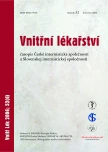Impact of endocannabinoid system in modulation of the metabolic syndrome
Authors:
A. Šulcová
Authors‘ workplace:
Farmakologický ústav Lékařské fakulty MU, Brno, vedoucí prof. MUDr. Alexandra Šulcová, CSc.
Published in:
Vnitř Lék 2006; 52(6): 615-618
Category:
Original Contributions
Overview
Endocannabinoid system, the complex of specific cannabinoid receptors (CB1 and CB2 subtypes) and their endogenous agonistic ligands (endocannabinoids) plays, besides others, an important role in the central and peripheral regulation of food intake, fat accumulation, and lipid and glucose metabolism. Alterations of these functions are associated with endocannabinoid system hyperactivity. The cannabinoid receptor CB1 antagonist rimonabant normalizes the over activated endocannabinoid system which contributes to the regulation of energy homeostasis, and improves lipid and glucose metabolism - decreases body weight, waist circumference, intra-abdominal obesity and triglycerides, increases HDL-C, improves insulin sensitivity according to HOMA index. Results of the international multicentric clinical trials confirm that rimonabant is well tolerated and show antiatherogenic effects (increased adiponectin, decreased marker of inflammation CRP and improvement of LDL profile) as well as decreased percentage of subjects with NCEP/ATPIII (National Cholesterol Education Program Adult Treatment Panel III) defined metabolic syndrome. Thus, the CB1 cannabinoid receptor antagonist rimonabant is suggested to be a prospective drug decreasing cardiometabolic risk factors.
Key words:
cannabinoid receptors - endocannabinoids - antagonist rimonabant - cardiometabolic risk factors
Sources
1. Gaoni Y, Mechoulam R. Isolation, Structure, and Partial Synthesis of an Active Constituent of Hashish. J American Chem Society 1964; 86 : 1646-1647.
2. Devane WA, Dysarz FA, Johnson MR et al. Determination and characterization of cannabinoid receptor in the brain. Mol Pharmacol 1988; 34 : 605-613.
3. Howlett AC, Bidaut-Russell M, Devane WA et al. The cannabinoid receptor: biochemical, anatomical and behavioral characterization. Trends Neurosci 1990; 3 : 420-423.
4. Howlett AC, Barth F, Bonner TI et al. International Union of Pharmacology. XXVII. Classification of cannabinoid receptors. Pharmacol Rev 2002; 54 : 161-202.
5. Pertwee RG. Cannabinoid receptor ligands: clinical and neuropharmacological considerations, relevant to future drug discovery and development. Expert Opin Inv Drug 2000; 9 : 1553-1571.
6. Williamson EM, Evans FJ. Cannabinoids in clinical practice. Drugs 2000; 60 : 1303-1314.
7. Porter AC, Felder CC. The endocannabinoid nervous system: unique opportunities for therapeutic intervention. Pharmacol Ther 2001; 90 : 45-60.
8. Rondon P. Therapeutic aspects of cannabis and cannabinoids. Br J Psychiatry 2001; 178 : 107-115.
9. Grotenhermen F, Russo E (eds). Cannabis and cannabinoids. Pharmacology, toxicology, and therapeutic potential. Binghamton NY: Haworth Press 2002.
10. Devane WA, Hanuš L, Breuer A et al. Isolation and structure of a brain constituent that binds to the cannabinoid receptor. Science 1992; 258 : 1946-1949.
11. Mechoulam R, Ben-Shabat S, Hanuš L et al. Identification of an endogenous 2-monoglyceride, present in canine gut, that binds to the peripheral cannabinoid receptors. Biochemical Pharmacol 1995; 50 : 83-90.
12. Hanuš L, Abu-Lafi S, Fride E et al. 2-Arachidonyl Glyceryl Ether, a Novel Endogenous Agonist of the Cannabinoid CB1 Receptor. Proceed Nat Acad Sci USA 2001; 98 : 3662-3665.
13. Howlett AC, Breivogel CS, Childers SR et al. Cannabinoid physiology and pharmacology: 30 years of progress. Neuropharmacology 2004; 47 : 345-358.
14. Martin BR. Identification of the endogenous cannabinoid system through integrative pharmacological approaches. J Pharm Exp Ther 2002; 301 : 790-796.
15. Elphick MR, Egertová M. The neurobiology and evolution of cannabinoid signalling. Philos Trans R Soc Lond B Biol Sci 2001; 356 : 381-408.
16. Cota D, Marsicano G, Tschop M et al. The endogenous cannabinoid system affects energy balance via central orexigenic drive and peripheral lipogenesis. J Clin Invest 2003; 112 : 423-431.
17. Cota D, Marsicano G, Lutz B et al. Endogenous cannabinboid system as a modulator of food intake. Int J Obes Relat Metab Dosord 2003; 27 : 289-301.
18. Ravinet Triolou C. CB1 cannabinoid receptor knockout mice leads to leanness, resistence to diet-induced obesity and enhanced leptin sensitivity. Int J Obes 2004; 28 : 640-648.
19. Di Marzo V, Goparaju SK, Wang L et al. Leptin-regulated endocannabinoids are involved in maintaining food intake. Nature 2001; 412 : 822-825.
20. Bensaid M, Gary-Bobo M, Esclangon A et al. The cnnabinoid CB1 antagonist SR141716 increases Acrp30 mRNA expression in adipose tissue of obese fa-fa rats and in cultured adipocyte cells. Mol Pharmacol 2003; 63 : 908-914.
21. Osei-Hyiamna D, DePetrillo M, Pacher P et al. Endocannabinoid action at hepatic CB1 receptors fatty acid synthesis: role in diet-induced obesity. J Clin Invest 2005; 115 : 1298-1305.
22. Pi-Sunyer FX. Pathophysiology and long-term management of the metabolic syndrome. Obes Res 2004; 12(Suppl): 174S-180S.
23. Van Gaal LF, Rissanen AM, Scheen AJ et al. Effects of the cannabinoid-1 receptor blocker rimonabant on weight reduction and cardiovascular risk factors in overweight patients: 1 year experience from RIO-Europe study. Lancet 2005; 365 : 1389-1397.
24. Pagotto U, Pasquali R. Fighting obesity and asscociated risk factors by antagonising cannabinoid type 1 receptors. Lancet 2005; 365 : 1363-1364.
25. Eckel RH, Grundy SM, Zimmet PZ. The metabolic syndrome. Lancet 2005; 365 : 1415-1428.
26. Di Marzo V, Matias I. Endocannabinoid control of food intake and energy balance. Nature Neurosci 2005; 8 : 585-589.
27. Pi-Sunyer FX, Aronne LJ, Heshmati HM et al. Effect of rimonabant, a cannabinoid-1 receptor blocker, on weight and cardiometabolic risk factors in overweight or obese patients: RIO-North America: a randomized controlled trial. JAMA 2006; 295 : 761-775.
Labels
Diabetology Endocrinology Internal medicineArticle was published in
Internal Medicine

2006 Issue 6
Most read in this issue
- Nuclear receptors PPARα
- Prevalence and causes of reflux in deep venous system of the leg in patients with insufficiency of superficial veins
- Sustained monomorphic ventricular tachycardia in patients with structural heart disease. Different arrhythmogenic substrates, different options of palliative and curative treatment in the era of three-dimensional mapping
- Molecular genetic diagnostics and screening of hereditary hemochromatosis
